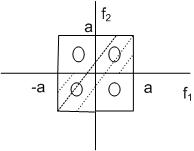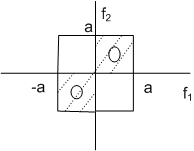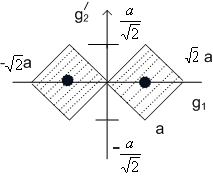f1 and  separately using scalar quantization and MMSE criterion.
separately using scalar quantization and MMSE criterion.
Since each of the two scalars has a uniform probability density function, the optimal quantizer is a uniform quantizer. If we allow 2 reconstruction levels for each scalar as,


Fig (3.4.4)
the optimal reconstruction levels for each scalar are a/2 and -a/2. The resulting four reconstruction levels are shown in Fig (3.4.4 ). Clearly 2 of the 4 reconstruction levels are wasted. With VQ we can reduce the number of reconstruction levels to 2 without sacrificing MSE as shown in Fig (3.4.4) This example shows that vector quantisation can reduce the number of reconstruction levels without sacrificing the MSE.
We can eliminate the linear dependence between f1 and f2 in this example by rotating the pdf clockwise by 450, as as shown in Figure (3.4.5).
In the new coordinate system, g1 and g2 are uncorrelated i.e.

Figure( 3.4.5)
In this new coordinate system, it is possible to place the two reconstruction levels at the filled-in dots shown in the figure by scalar quantisation of the two scalars, and the advantage of vector quantisation disappears. Hence, eliminating the linear dependence reduces the advantage of vector quantization in this example. This is consistent with the notion that vector quantisation can exploit linear dependence of the scalars in the vector.